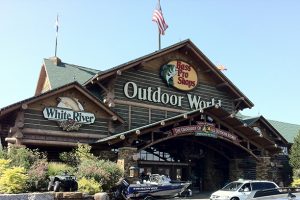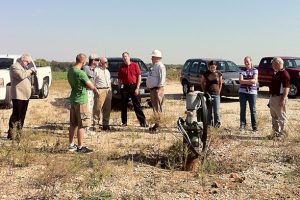At 7:15 a.m. Tuesday morning, I meet Bill O’Dowd in the lobby of the Saint George Hotel and we walk down Main Street for breakfast at the Weston Café. The sun is just starting to come up and few people are stirring on the streets. While we are waiting for our orders, we strike up a conversation with the waitress. She tells us the first wave of customers has come and gone, and she is now waiting for the second wave. She also tells us about the Apple Fest scheduled for next weekend and the Irish Fest scheduled for the following weekend. Sounds like fun. Bad timing on our part!

After a quick breakfast and cup of coffee, we check out of the hotel and head toward Iatan Generating Station. Iatan, named for a chief of the Otoe tribe, is located only a couple of miles upstream of Weston and is the flagship of KCP&L’s generation fleet. Iatan 2, completed in 2010, is a state of the art coal-fired generating unit which was named Power magazine’s 2011 Plant of the Year. At Iatan we meet up with Paul Ling, KCP&L‘s Manager of Environmental Services, who accompanies us to the future drilling site. Based on nearby well logs, the Iatan boring (Exploratory Borehole No. 3) is projected to reach the confining layer at a depth of 2,565 feet, the Lamotte Sandstone at a depth of 2,670 feet, and Pre-Cambrian basement rock at a depth of 2,745 feet. We review the well site layout with Paul and relate that our projected schedule for commencement of drilling at Iatan is December 1. Since Iatan is located within the floodplain of the Missouri River, advancement of the borehole through 100 to 150 feet of unconsolidated alluvial deposits and management of possible flood events are major considerations at this site.
Touring Missouri’s Physiographic Regions
Following our meeting at Iatan, we settle back into the pickup truck for the 200-mile drive to Springfield. At downtown Kansas City, we cross the Missouri River for the second time and pass from the Dissected Till Plains physiographic region into the Osage Plains physiographic region. The Osage Plains constitute the eastern extension of the Great Plains into Missouri. It extends southward to Joplin and eastward to Sedalia. The region is underlain by layers of limestone, shale and coal, and contains most of the oil and gas fields in the state. The region is also a thriving farming area, and we pass a number of new and used farm implement companies along our route.

Around Osceola (in this case named for a leader of the Seminole tribe) we begin to transition from the Osage Hills physiographic region to the Salem Plateau physiographic region, as rolling farmland gives way to more pronounced hills, valleys and knobs. The town of Osceola also has a direct connection to the Missouri-Kansas “border wars” which occurred prior to the Civil War. The town was burned and looted in 1861, and has never recovered to its pre-Civil War size. The Salem Plateau is a deeply dissected highlands area that extends across much of southern Missouri. Geologically, the region is a broad dome which encircles the St. Francois Mountains. The plateau is underlain by a thick sequence of dolomites and sandstones, and contains many of the scenic rivers and large springs in the state. Much of the region is forested. The Ozark National Scenic Riverways, which encompasses the Current and Jacks Fork Rivers, was established by Congress in 1964 and became our first national park based on a river system.
Approximately fifteen miles north of Springfield, we begin to climb a long grade (the Eureka Springs Escarpment) which takes us from the Salem Plateau physiographic region to the topographically and stratigraphically higher Springfield Plateau physiographic region. I call the Springfield Plateau the “roof of Missouri.” The region is centered on the City of Springfield and extends westward to Joplin and eastward to Cedar Gap. Elevations increase as you move eastward across the plateau. The eastern edge of the plateau is generally arrow-shaped, with the arrow pointing directly toward the St. Francois Mountains–this because the St. Francois uplift tilted all of the sedimentary strata away from the center of the uplift. The highest elevation in Missouri (1,772 feet) is Taum Sauk Mountain in the St. Francois region. The second highest elevation (1,744 feet) is Lead Hill, at the eastern edge of the Springfield Plateau. Although there are several other isolated peaks which rise above 1,700 feet in the St. Francois region, there are square miles of land above that elevation near the eastern edge of the Springfield Plateau. Not an extraordinary elevation by many standards, but significant when you consider that the lowest point in Missouri is only 230 feet above sea level.

In Springfield, we meet Dave Fraley, MCSP Principal Investigator, along with Steve Bodenhamer and Bill Alter, other members of the MCSP management team, for lunch at Hemingway’s, a restaurant inside Bass Pro Shops national headquarters. The National Headquarters is an ever-changing landscape (it seems they never stop construction) and one could spend hours looking at camping gear, fishing tackle, boats, and wildlife displays. However…(sigh!)…duty calls and we head toward City Utilities’ John Twitty Energy Center (JTEC) instead to meet with Missouri State University researchers and to inspect Borehole No. 1.
At JTEC, we meet up with Dr. Gouzie and Dr. Rovey, and several of their graduate students, along with Rod Spence, MCSP management team, and Bryan Feemster, power plant director. A carbon dioxide injection test was originally planned for JTEC, but water samples obtained from Borehole No. 1 confirmed that the water quality of the Lamotte Sandstone beneath the site was “too good” to be used for carbon sequestration. EPA regulates and protects aquifers having total dissolved solids concentrations below 10,000 mg/L as Underground Sources of Drinking Water (USDWs). Total dissolved solids concentrations within the Lamotte were found to run around 150 mg/L. The borehole was subsequently converted to use as a non-potable water supply well for power plant operations.

I also talked to Chuck Rovey, an expert on Missouri glaciology, about the broad floodplains and “underfit” stream channels I puzzled over during our drive across northern Missouri yesterday. Dr. Rovey confirmed what I was beginning to suspect–that the broad floodplains are ancestral (pre-glacial) channels of the Missouri River. During the glacial period, the Missouri River was “pushed” farther to the west by continental glaciation. Mystery solved! My world has order again!
Following our meeting at JTEC, we jump back in the truck for our 120-mile drive to Rolla. At Northview, we drop off the Springfield Plateau surface and back onto the Salem Plateau surface. After checking into Drury Inn in Rolla, we meet up with Dave Wronkiewicz, an MS&T professor and a member of the carbon sequestration research team, who has graciously offered to join us for dinner. Dr. Wronkiewicz (thankfully) offers to drive and I quickly accept. After considering the options, we decide on Gordoz, a Mediterranean restaurant and one of my personal favorites. Over a nice dinner at the end of a very long day, conversation turns to football. Tomorrow we will meet with researchers at MS&T and DGLS, inspect core from Boreholes 1 and 2, and drive to St. Louis to visit the Ameren Missouri drilling site.